There are more than 30,000 Out-of-Hospital Cardiac Arrests (OHCA) each year in the UK. Sadly, just 1 in 10 victims survive an OHCA. However, CPR performed by a bystander can increase the casualty's survival chances.
15% of cardiac arrests occur in the workplace, so it's important for all staff to understand what a cardiac arrest is and how the Chain of Survival can help you save someone's life.
What is a cardiac arrest?
A cardiac arrest is the result of the heart stopping pumping blood around the body. This causes the victim to collapse and stop breathing normally or even at all, whilst they may go grey in colour.
%20(1).webp?width=795&height=352&name=CPR%20in%20the%20workplace%20(1)%20(1).webp)
A cardiac arrest can happen anywhere, including the workplace. Performing immediate CPR can save a live.
Causes of cardiac arrest
There are a number of causes of cardiac arrests, including ventricular fibrillation (VF), a heart attack, cardiomyopathy, congenital heart disease, hypoxia, or drug overdose.
Hypoxia, when the body tissues don't get enough oxygen, is an example of several reversible causes of cardiac arrests, known as the 4 Hs and 4 Ts. Whilst a first aider may not be able to help reverse these causes, it is very useful to consider these when dealing with someone experiencing a cardiac arrest. For instance, discovering vomit or a foreign object blocking the airway will help you identify the cause and you can try to remove it before performing any CPR.
Signs and symptoms of cardiac arrest
Identifying symptoms and signs of cardiac arrest can allow for early prevention but also means that you can be sure that you should take immediate action. You can identify signs of a cardiac arrest if the person:
- Collapses suddenly
- Has no pulse
- Is not breathing
- Loses consciousness
If someone complains of the following symptoms, this may also indicate that a cardiac arrest may soon follow:
- Chest discomfort
- Shortness of breath
- Feeling weak
- Heart palpitations
If someone suffers any of these symptoms, medical attention should be immediately sought.
So, what's the difference between a cardiac arrest and a heart attack?
Cardiac arrest vs heart attack
The fundamental difference between a cardiac arrest and a heart attack is that cardiac arrest is much more urgent, although both situations require you to call 999 for an ambulance immediately.
As mentioned, a cardiac arrest occurs when the heart fails to pump blood around the body and stops beating, causing the casualty to lose consciousness and stop breathing. A heart attack is a result of coronary heart disease (CHD), caused by a blockage in one of the coronary arteries, meaning the heart muscle fails to receive its vital blood supply and the person no longer gets enough oxygen.
For a heart attack victim, call 999, remain with them and get them to stay calm whilst sitting in a comfortable position. You should give them an adult tablet of aspirin (300 mg), if you have one accessible and as long as they are not allergic to aspirin, whilst you wait for the emergency services to arrive. Treating a cardiac arrest is more complicated as it requires CPR and/or defibrillation, which is explained next.
What are the four links in the Chain of Survival?
The Chain of Survival outlines the four steps to give you the best chance of saving someone suffering from an out-of-hospital cardiac arrest.
1) Early Prevention & Recognition
Prevention is better than cure. So, if you spot any signs of cardiac arrest, act immediately.
Some signs and symptoms may be obvious. For instance, if they have told you their symptoms or you see what has caused the cardiac arrest.
However, if you find someone on the floor, perform a primary survey to establish what actions you should take. First, check the surroundings for danger so you can perhaps work out what happened. This is also important in keeping you safe.
|
A primary survey, also known as DR ABC(D), is carried out by a first responder in a medical emergency to determine what has happened to the casualty and how to act. Find out more here: 'First Aider Essentials - Acronyms for first aid emergencies'. |
Next, check for response. If the casualty is unconscious and/or unresponsive, check the airway for anything obstructing it and then see if they are breathing. To do this, put your ear to the mouth, looking down their body to see if their chest moves up and down or you may feel their breath against your ear.
If they are not breathing, call 999 and begin CPR immediately. You should also shout for help from others nearby - this way you can focus on performing emergency first aid whilst they helper contacts the emergency services.
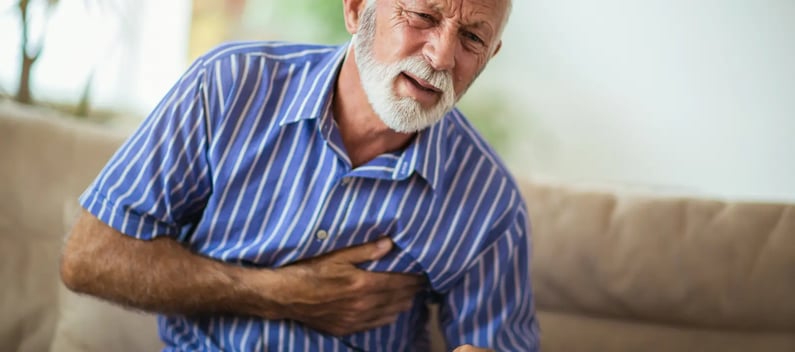
Complaints of chest discomfort may be a symptom of a cardiac arrest and medical attention should be sought.
2) Early CPR
To increase the chances of survival for the victim, cardiopulmonary resuscitation (CPR) is carried out. This involves two important actions: chest compressions and rescue breaths.
Chest compressions help pump blood around the body. To perform these, place the heel of your hand in the centre of the person's chest and clasp your hands together, placing one hand on top of the other. You should then press down hard (5 to 6cm or 2 to 2.5 inches) and fast (100-120 compressions per minute) to the rhythm of 'Smoke on the Water' or 'Baby Shark'.
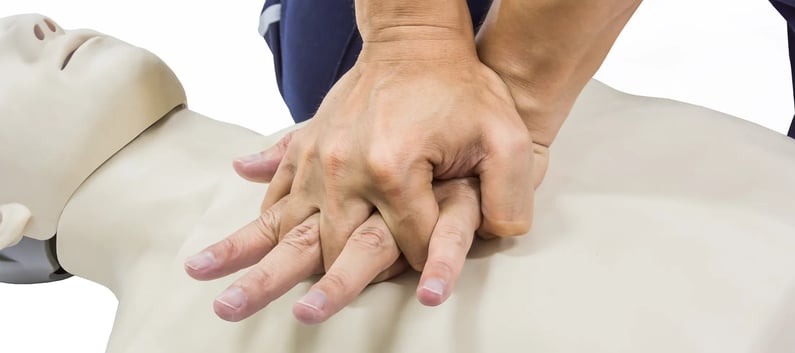
Clasp your hands together and place in the centre of the chest to perform chest compressions during CPR.
| CPR is performed at a rate of 100-120bpm. The British Heart Foundation's 'Life Saving Beats' resource shows songs with the same rhythm to use as a guide. |
Rescue breaths should then be used to provide the person oxygen to help them breathe again. For every 30 chest compressions, it is then recommended to give 2 rescue breaths. Rescue breaths are performed by first tilting the casualty's head and lifting their chin simultaneously. Then, use one hand to pinch their nose and place your mouth over their mouth (making a complete seal) before giving a rescue breath that lasts about 1 second, causing their chest to rise. Allow the air to exit before performing the second rescue breath.
If rescue breaths are not possible, for example if a foreign object is lodged in the airway, continue with just chest compressions.
Remember: give 2 rescue breaths for every 30 chest compressions performed.
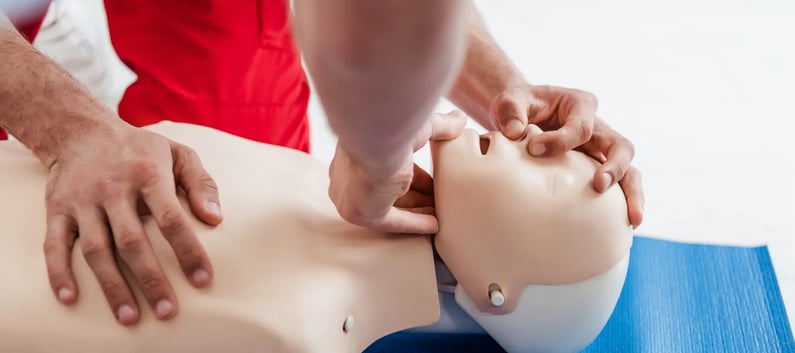
Pinch the nose, lift the chin to tilt the head and seal their mouth with your mouth to perform rescue breaths.
3) Early Defibrillation
An AED (Automated External Defibrillator) uses electrical defibrillation to help regain the patient’s regular heart rhythm or restart their heart altogether. Using an AED within the first 3 minutes of sudden cardiac arrest can increase survival rates by over 80%.
An AED provides the user with step-by-step audio and/or visual instructions on how to use it. First, remove the casualty's top in order to place the AED's pads on their bare chest, ensuring that it is safe for the electric shocks to be delivered to the patient. If the patient is wet or lying in water then you will need to move them away from the water and dry their chest before using the AED.
|
When should you not do CPR or use an AED? |
It is vital that regular checks are carried out to ensure that all AEDs on-site are operable – the device performs regular self-tests and should have an on-screen indicator, such as a green light, to show that it is safe to use.
The ambulance call handler will help you or your helper locate the nearest defibrillator. If there is not a defibrillator present, you should continue to give CPR until the emergency services arrive.
4) Post-Resuscitation Care
Continuous CPR and defibrillation should be maintained on the cardiac arrest victim until they regain a normal breathing rhythm, or until the emergency services arrive to take over and take the person to the hospital.
Should the casualty make a recovery, or ROSC (return of spontaneous circulation), post-ROSC care should focus on maintaining their breathing and circulation.
|
Automated External Defibrillation Course |
Understanding the Chain of Survival and its importance in potentially saving the life of someone experiencing cardiac arrest, through resuscitation and defibrillation, really can be the difference between life or death.
Please note that the Chain of Survival above is only for adults suffering cardiac arrest. The procedure, such as how CPR is carried out, differs for children and infants. First aid for children and infants is covered in our Paediatric First Aid training course.
We offer multiple other training courses that teach learners the fundamentals of first aid, resuscitation and the use of AED machines, including:
- Automated External Defibrillation (AED)
- First Aid Awareness
- Choking Prevention and Resuscitation Awareness
All these courses and more are available on our First Aid training page.

-1.webp?width=243&height=74&name=Logo%20R%20Homepage%20White%20Final%20Horizontal%20Large%20NEW%20small%20(2)-1.webp)
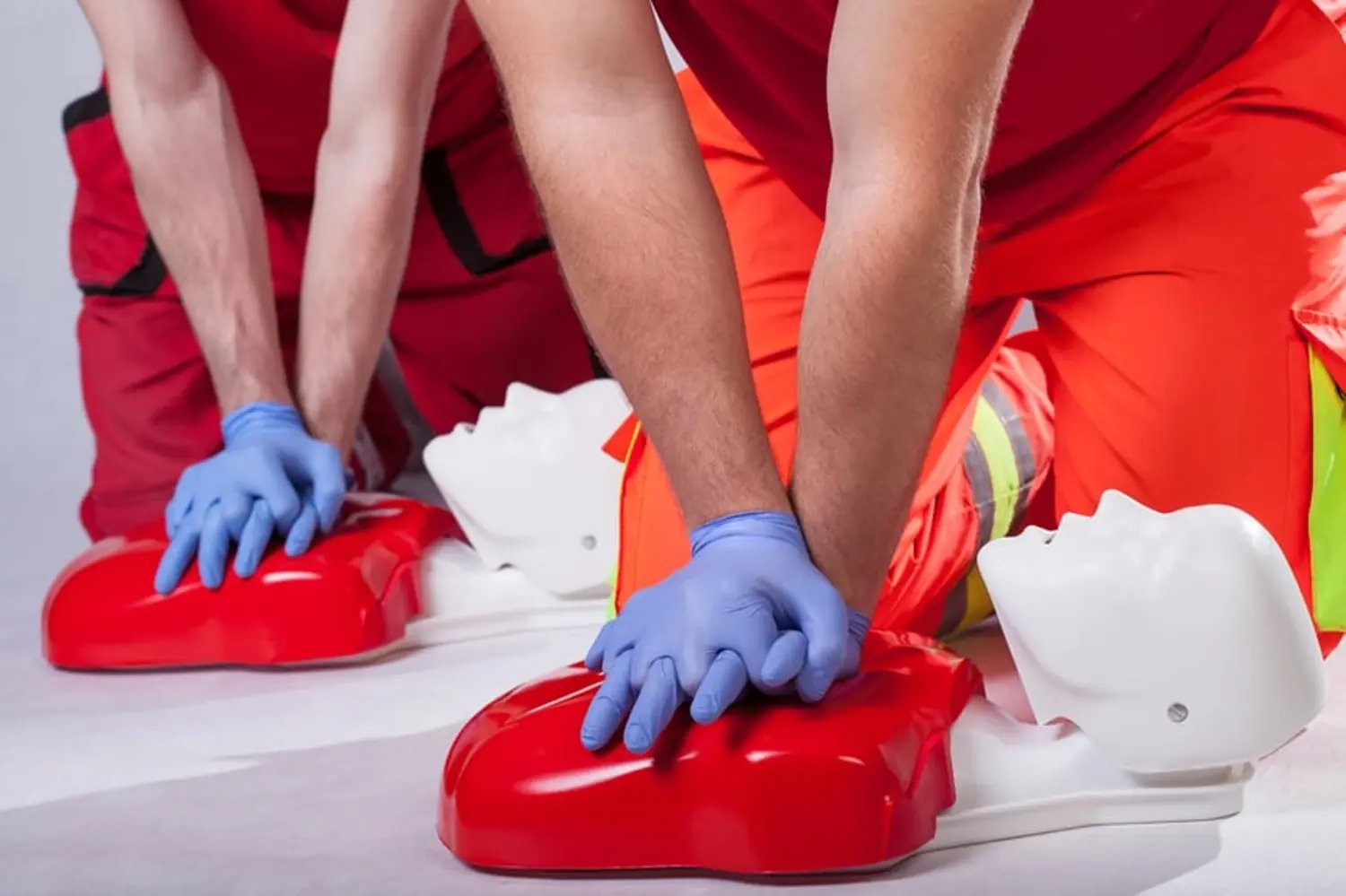
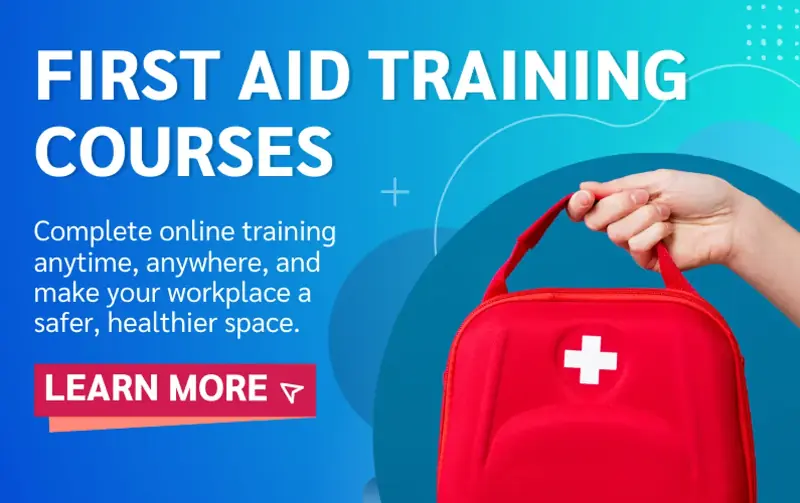

-1.webp?width=50&height=59&name=Cyber%20Essentials%20Badge%20Large%20NEW%20(72dpi)-1.webp)
COMMENTS